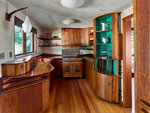Chestnut Hill’s Louis I. Kahn-designed Margaret Esherick House has just been named to the prestigious National Register of Historic Places.
This item is available in full to subscribers.
We have recently launched a new and improved website. To continue reading, you will need to either log into your subscriber account, or purchase a new subscription.
If you are a digital subscriber with an active subscription, then you already have an account here. Just reset your password if you've not yet logged in to your account on this new site.
If you are a current print subscriber, you can set up a free website account by clicking here.
Otherwise, click here to view your options for subscribing.
Please log in to continue |



Chestnut Hill’s Louis I. Kahn-designed Margaret Esherick House, known by architectural historians as “one of the most significant residential structures built in the second half of the twentieth century in the United States,” has just been named to the prestigious National Register of Historic Places.
The nomination was presented by the building's current owners, Paul Savidge and Dan Macey, who said in a news release that they are "honored that the Department of Interior has listed the Margaret Esherick house on the National Register and happy that both Louis Kahn and Wharton Esherick are being nationally recognized for their work together."
"We are so appreciative to now have Louis Kahn's brilliant vision enshrined alongside Frank Lloyd Wright's Fallingwater and other 20th-century architectural masterpieces on the National Register," Savidge said.
According to the nomination documents, “Kahn’s few residential designs are especially important as representative of his core architectural principles…, The house retains remarkable integrity being extremely intact from its original completion fifty years ago.”
Macey and Savidge, who are married, purchased the home in 2014.
"We also want to thank the three previous owners who had the foresight to understand the genius of Kahn and contribute to its ongoing preservation," Savidge said.
Khan built the modernist residence on the edge of Pastorius Park in the heart of the Chestnut Hill historic district between 1959 and 1961 for his client and local bookstore owner Margaret Esherick. Her uncle, Wharton Esherick is considered the father of the modern studio craft movement and designed the home's signature sculptural copper and wood kitchen.
Khan, who was known for his careful understanding of the site chosen for any of his designs, had a special appreciation for the distinct nature of Chestnut Hill.
"We can only know Chestnut Hill as a spirit. Its character amounts to a kind of agreement stronger than a law or a set plan or an idea of some isolated area,” he said at a 1970 panel discussion organized by the Chestnut Hill Conservancy with three architectural giants who had just built new homes in Chestnut Hill, including Robert Venturi, and Romaldo Giurgola. “It seems as though the trees and gardens and the carefully scribbled streets seem to have told everyone to lay off exploiting it and to be discerning about the steps to be taken. This kind of agreement could enter the works of architects, planners and preservationists."
“Kahn did not seek to build the Margaret Esherick House in a traditional style with typical Chestnut Hill materials, and yet understood the community so well that he was still able to create his own version of harmonious beauty,” said Lori Salganicoff, executive director of the Chestnut Hill Conservancy. "As both poet and architect, Louis Kahn's vision of Chestnut Hill contributed richly to how we understand the community today.”
The one-bedroom, 2,500-square-foot house is a unique and elegant expression of a new direction in residential architecture. The concise layering of concepts and ideas that Kahn had been developing is what makes the building so iconic, and important to architectural history.
His ideas of clearly defined “served” and “service” spaces, organizing movement around an axis and using the interplay between light and materials worked together to create a delightful light-filled jewel of a house – which possesses a timeless monumentality of its own.
“The light coming through the windows changes all the time, depending on the time of day or the season. But it is always a very soothing and comforting light that makes the house a wonderful place to work, read and just be," said current owner Dan Macey.
The Esherick House has received numerous preservation accolades over the years. In 1992, it was given the Landmark Building Award from the Philadelphia Chapter of the American Institute of Architects. The house was added to the Philadelphia Register of Historic Places in 2009 and inducted into the Chestnut Hill Conservancy’s Architecture Hall of Fame in 2015. Macey and Savidge have been honored for their preservation efforts by the Chestnut Hill Conservancy, the Preservation Alliance for Greater Philadelphia and Docomomo-us.
The Department of Interior approved its addition to the Register based on its architectural significance as an iconic modernist building and a premier example of Kahn's design principles applied to a smaller scale.
Built for $35,000, the cost of Kahn's design fees actually exceeded the construction expenses. But the lasting value of the Esherick house has proved to be priceless, as an iconic example of modern architecture that still feels fresh and contemporary even 60 years after its completion.
The National Register of Historic Places is the nation’s official list of historic resources worthy of preservation. It is administered by the National Park Service, part of the U.S. Department of the Interior.
Listing on the National Register provides some protection for historic structures from adverse impacts by federally funded or permitted projects, adding to the existing protections provided by listing on the Philadelphia Register. The Margaret Esherick House now joins the only 50 other individually listed properties on the National Register in Germantown, Mt. Airy, and Chestnut Hill, including Gravers Lane Station, Wissahickon Inn, Cliveden, Wyck, and the Violet Oakley.
Edward Robinson contributed to this article